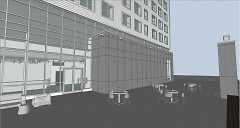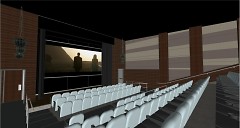When the Director of MCA Denver, Adam Lerner, toured the new UICA, he said that he loved how the building felt like a “cityscape.” He also noted that UICA's space would present contemporary art as it should be—like walking through an urban neighborhood. As we prepare to move into our new home, UICA Staff wanted to talk with the individuals who have been integral in the design of our new facility. Here is the interview.
Arden Freeman -
Principal at Built Form
Valerie Schmeider -
Principal at Via Design
Dan Teunis -
Project Manager/Designer, Via Design
Emily Vanderlaan -
Interior Designer, Via Design
Jeff Meeuwsen -
Executive Director, UICA
What inspired your work on this project?
Arden: The approach is similar to Antoine Predock’s in that every move is a response to the existing context—in this case, the built environment.
Val: The Getty Museum in L.A. was inspirational, not because of the architectural style, but because of the new “attitude” of museums and galleries like the Getty. They are more than a place to display artwork. They are cultural facilities “where art happens.”
Dan: The New Museum by Sanaa in New York—it’s designed to serve the art and not compete with it.
Jeff: I am a habitual museum and gallery visitor whenever I travel, so I have developed quite an index of ideas over the past twenty years. I was also influenced by meetings with several leaders of national contemporary art centers who shared what works and what doesn’t in their own buildings.
What is the most important feature of the project?
Arden: The most important feature is the main stair/street level gallery, which simultaneously connects the UICA to the city and the individual UICA spaces to each other.
Val: If I had to choose one feature, I would choose the rooftop terrace. This is such a unique urban “outdoor room” that offers numerous opportunities for displaying or performing art, for showing film, for gathering, lounging, or just enjoying the out-of-doors. This space offers something not found at any other downtown cultural facility.
Emily: The Film Theatre on the lower level and the Black Box Performance Theatre on the 4th level will be totally unique yet harmonious with the rest of the building.
Jeff: Unique spaces that inspire artists to experiment and to respond are critical. We will offer a 40´ vertical gallery, a giant project wall, areas for suspended work, a floor vault, a rooftop terrace, and more.
How will it function as an arts center?
Val: This center will not only feature current and site specific art in both visual and performing arts, it will also educate, inspire, entertain, and promote the arts to all.
Arden: One unique aspect of UICA is that art can be both created and displayed in the same space, so the new facility will showcase this aspect in a very public way—ideally making contemporary arts more accessible.
Emily: The planned flexibility of the spaces is critical to the function of the art center. The gallery spaces, studio spaces and public spaces can be easily revamped to best service the next program.
Jeff: Very few national art centers combine working studios, multiple disciplines, a residency program, youth programs, a prominent location and artwork that is, by and large, by emerging or underrepresented artists. We are filling an important niche.
And as a community gathering space?
Arden: I always believed UICA programming is what facilitated community gatherings. The new space will allow more of this to happen and in a more memorable way.
Emily: The space will offer on-the-pulse arts exploration with a variety of gathering spaces that encourage collaboration.
Dan: With its location on the “Avenue for the Arts,” I believe it will be an anchor for the arts community and for the community as a whole.
Jeff: Contemporary art has the remarkable power to help us learn about each other and about our world. I hope that UICA is increasingly a space where people come to slow down, to connect, and to be changed in some way.
What does the new UICA tell the world about West Michigan?
Arden: Culturally, there’s something happening here.
Emily: The “unlikely” location of Grand Rapids is recognizable as a hip, cultural center.
Dan: That we are a forward-thinking city that loves art.
Jeff: Placing a significant laboratory for new art in our city’s center shows that we value emerging creative talent, ideas and innovation. When you think of the new UICA alongside our region’s other cultural resources and design-centric companies, you begin to see just how significant creativity is to this community.
Anything else you want to add?
Jeff: This space is extraordinary—a perfect reflection of the many, many incredible donors, designers, volunteers, artists, and staff people who have helped to grow UICA over the past 34 years. My thanks go out to each and every one of you. We should all be very proud.
The Rapidian, a program of the 501(c)3 nonprofit Community Media Center, relies on the community’s support to help cover the cost of training reporters and publishing content.
We need your help.
If each of our readers and content creators who values this community platform help support its creation and maintenance, The Rapidian can continue to educate and facilitate a conversation around issues for years to come.
Please support The Rapidian and make a contribution today.



